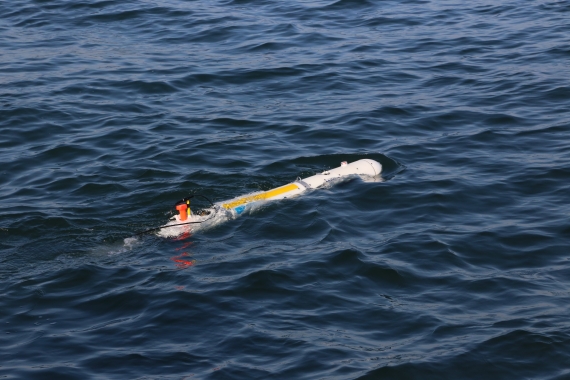MARES
Autonomous Underwater Vehicle (AUV)
Description
MARES (Modular
Autonomous Robot for Environment Sampling) is an Autonomous Underwater Vehicle
(AUV), which has been developed by INESC
TEC and the Ocean Systems Group (OceanSys) of the University of Porto. It is operating since 2007.
MARES is a highly modular
autonomous underwater vehicle, designed for shallow water operations. The
vehicle can be configured to carry a wide variety of oceanographic sensors and
includes a set of navigation sensors to ensure that the predefined trajectories
are followed.
Specifications
General
- Vehicle type: Autonomous Underwater Vehicle (AUV)
- Body shape: torpedo
- Body material: polyacetal
- Deployment: two hooks for craning, towing and pulling
- Length: 1.6 m
- Diameter: 20 cm
- Weight in air: 32 kg
- Power: rechargeable batteries (Li-Ion, 600 Wh)
- Battery charge time: 5 h
- Payload capacity: 5 kg
- Payload interfaces: 5 ports with power and data links (reconfigurable)
Operation
- Maximum depth: 100 m
- Autonomy: 10 h
- Range: 40 km
- Propulsion: two horizontal and two vertical thrusters (all independent)
- Horizontal speed: 0-2 m/s
- Vertical speed: 0-0.5 m/s
- Degrees of freedom: surge, heave, yaw and pitch
- Communications: acoustic (underwater), Wi-Fi and serial radio (at surface)
- Navigation system: GPS and Long Baseline (LBL) acoustic network with navigation and instrumentation buoys (NIBs)
Sensors
- CTD (conductivity, temperature and depth)
- Side-scan sonar
- Turbidity
- Fluorescence
- Video camera
Features
- Compact and lightweight (easy transportation and deployment)
- Modular construction, with reconfigurable sections
- Spare ports to accommodate payload sensors
- Robust and safe, with fully shrouded moving parts
- Operates in confined areas (able to ascend/descend on the vertical)
- Hovers in the water column (station keeping and close inspection)
- Autonomous operation, with simple mission definition
- Low maintenance
Navigation and instrumentation buoys
Navigation and
instrumentation buoys (NIBs) are moored floating platforms with on-board
electronics and energy management system. The basic configuration includes
rechargeable batteries, a compact GPS receiver and a low-power radio modem.
NIBs can carry a great variety of sensors and transmit data in real time to a
shore station using the radio link.
NIBs are used as acoustic
navigation beacons for the MARES AUV. In this scenario, they have electronic
boards to receive and decode acoustic signals sent by the vehicle and respond
by transmitting other coded pings into the water. Since they are deployed in
known positions, the vehicle can determine its position by triangulation.
During an AUV mission, the buoys also relay navigation information back to a
mission control station, allowing for vehicle tracking and mission supervision.
NIBs have the following specifications:
- Diameter: 75 cm
- Weight in air: 30 kg
- Net buoyancy: 20 kg
- Antenna height above seawater: 1 m
Applications
- Underwater environmental monitoring
- Underwater inspection
- Seabed mapping
- Underwater surveillance
- Oceanography
- Data collection
Photos and
videos are available at the Gallery.
